The AMD Radeon VII Review: An Unexpected Shot At The High-End
by Nate Oh on February 7, 2019 9:00 AM ESTProfessional Visualization and Rendering
With AMD strongly pushing the Radeon VII as a prosumer content creation card, it behooves us to look at rendering, CAD, and professional visualization performance. However, accurate and applicable benchmarks for this field are not so easy to find, especially since performance is highly dependent on workflow and proprietary licensed ISV software. Given AnandTech’s audience, which often includes engineers using these applications in critical production environments, our goal is to provide the most relevant metrics. However, as Ian has discussed previously, the route to the most accurate workstation benchmarking for professional applications is in the hands of ISVs, who are at best blasé and more typically negative about providing access, even at the prospect of lending limited software licenses in return for ongoing discussion and third-party benchmark data of their software.
Those caveats in mind, the next best thing for evaluating overall GPU workstation performance is the venerable SPECviewperf, recently updated to version 13. Separated into ‘viewsets,’ which are a group of application-specific workloads derived from real-world datasets, SPECviewperf has been a longstanding suite for generalized workstation/CAD GPU performance. For SPECviewperf 13, the viewsets are based on:
- Autodesk 3ds Max 2016 (Nitrous DX11 driver)
- Dassault Systèmes CATIA V6 R2012
- PTC Creo 3 & Creo 4
- Geosurvey software, with workloads based on rendering techniques utilized by the open-source OpendTect seismic visualization application
- Autodesk Maya 2017
- Radiological (i.e. CT, MRI scans) rendering, with workloads using the Tuvok rendering core of the ImageVis3D volume visualization application
- Autodesk Showcase 2013
- Siemens NX 8.0
- Dassault Systèmes Solidworks 2013 SP1
While we didn’t have time for complete benchmarking of video editing/production software such as Adobe Premiere Pro CC, we will be looking to include that in the future.
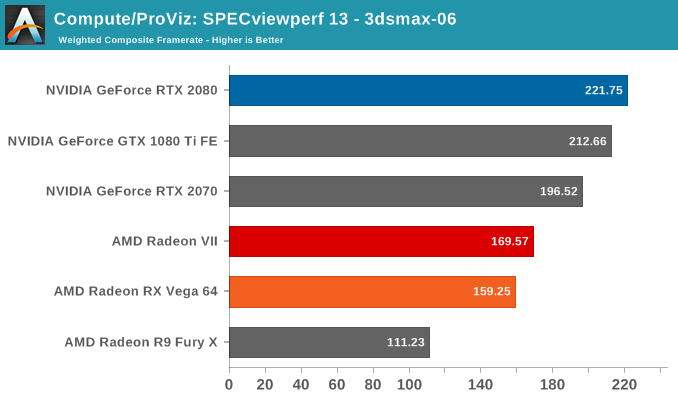
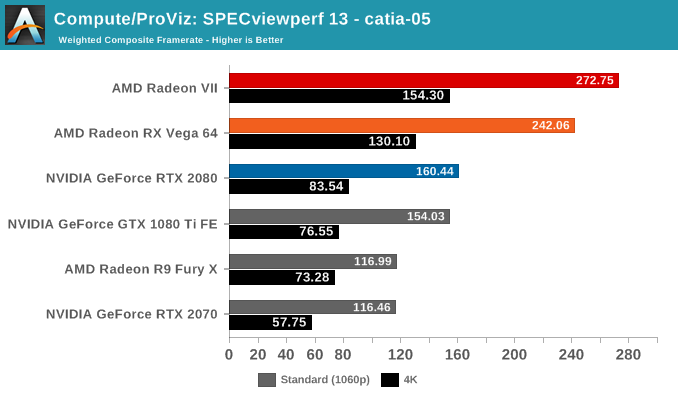

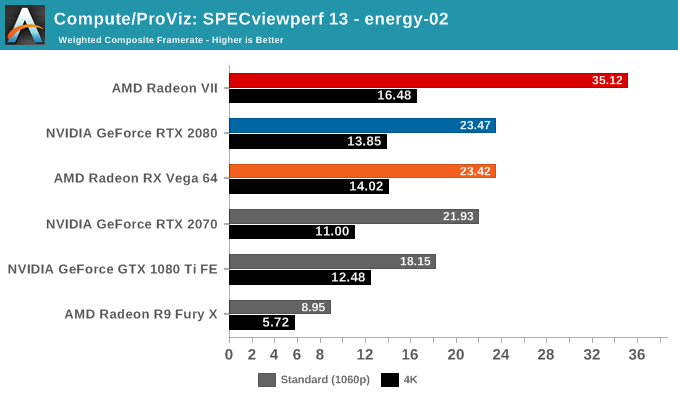
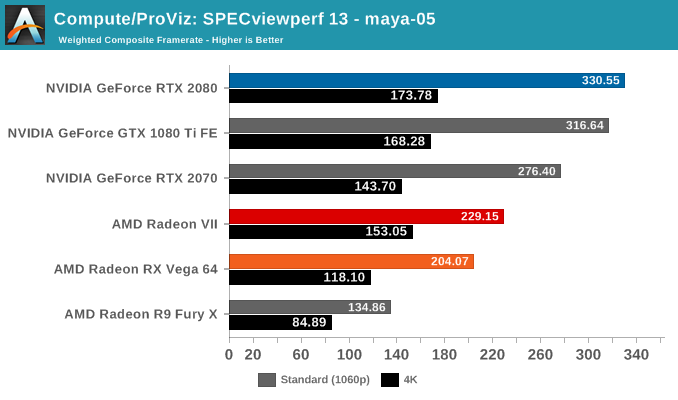
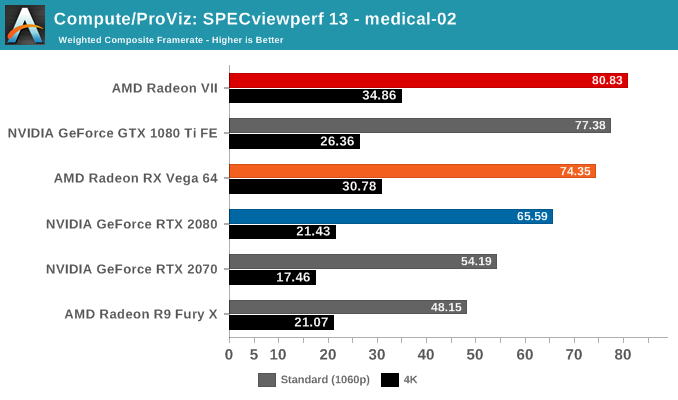
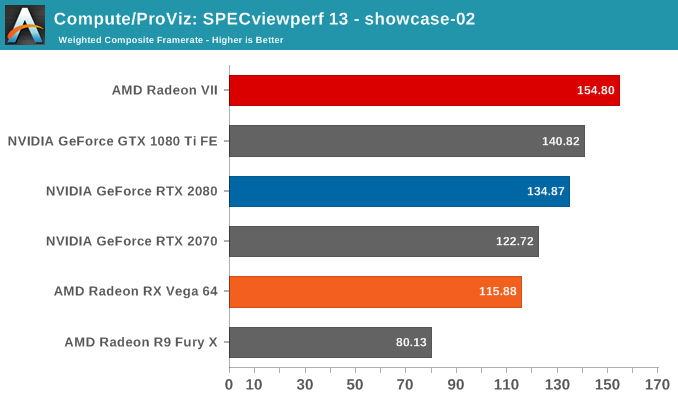
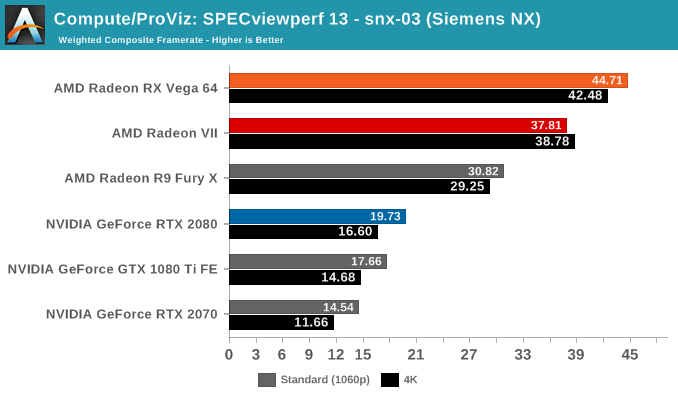
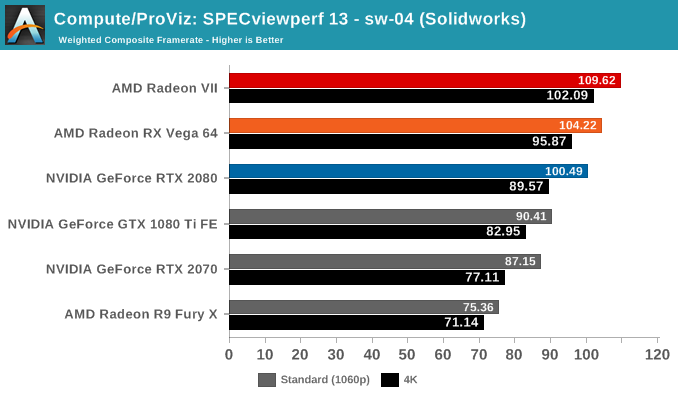
Looking over the results, it's clear that certain viewsets tend to perform better on one vendor's hardware than the other's. In those cases, the Radeon VII doesn't buck the trend, though in Siemens NX the lower performance is more likely than not related to driver maturity. In the reverse scenarios like in creo-02 or maya-05, the Radeon VII is in a similar spot, naturally ahead of the RX Vega 64 but behind the competing RTX and GTX cards. If anything, the results highlight the importance of software maturity for newer hardware, but there are definite signs of Vega 20 being a powerful workstation card. The caveat is that it doesn't seem to change the overall landscape for worksets that traditionally perform well on NVIDIA hardware.
Our next set of benchmarks look at rendering performance. To be clear, given the nature of ‘render wars’ as well as the adoption of CUDA, the featured render engines are not necessarily indicative of the overall GPU renderer landscape. Because we are looking at the Radeon VII, it’s not applicable to include some of the more popular renderers, such as Redshift and Octane, which are CUDA-only, and similarly the presence of Indigo Renderer helps as another datapoint even though it is less popular.


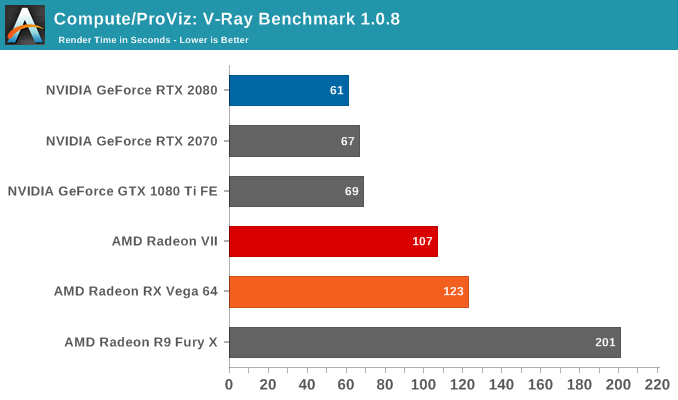

To note, official Blender releases have yet to incorporate CUDA 10, and so RTX 20 series cards are not officially supported.
V-RAY here is the only test that utilizes CUDA for NVIDIA cards, while the rest all use OpenCL. The results seem broadly similar to SPECviewperf, where the Radeon VII continues to excel at workloads where AMD hardware generally fare well.










289 Comments
View All Comments
Oxford Guy - Thursday, February 7, 2019 - link
This card is a turkey for gamers. AMD fixed the noise level problem with Fury X and now we're getting less value than we did then. It's too loud."Also new to this card and something AMD will be keen to call out is their triple-fan cooler, replacing the warmly received blower on the Radeon RX Vega 64/56 cards."
Is the sarcasm really necessary? If you're going to mention the cooler thing why not point out just how far AMD has regressed in terms of noise. Remember Fury X, a card that is nice under load?
"Vega 20 has nothing on paper to push for its viability at consumer prices. And yet thanks to a fortunate confluence of factors, here we are."
Oh please:
Fiji: 596 mm2 for $650. Vega 10 495 mm2 for $500. Vega 20 331 mm2 for $700.
Anandtech says it's all so shocking that Vega 20 is available to consumers at all. Eyeroll. No. For $700, AMD could have put that extra die area to more use and given us 8 GB of VRAM. But that would involve doing the impossible and making a GPU that is attractive to gamers, not just peddling low-end Polaris rehashes indefinitely.
Consumers aren't getting the best value here. They're getting leftovers just as they did with Bulldozer/Piledriver — parts that were targeted at the server market first and not consumers. At least with Vega 20, though, there is some competitiveness, although this is mainly because Nvidia is artificially crippling the value of the GPU market with its inflated pricing strategy. That is what monopolies do, of course. Look at how long Intel was able to coast with Sandy-level performance.
"At 3.5 TLFLOPS of theoretical FP64 performance, the Radeon VII is in a league of its own for the price. There simply aren’t any other current-generation cards priced below $2000 that even attempt to address the matter."
That's marvelous for the people who are able to care about FP64, unlike gamers.
This is what happens when there isn't enough competition in a market. Gamers get the choice of two shafts: Turing and Vega.
Oxford Guy - Thursday, February 7, 2019 - link
Oh, yes... and the "console".At least the Switch is a real console. I'm not talking about that. I'm talking about awful low-end PCs being falsely called consoles, which has been the practice since Jaguar became an (unfortunate) thing.
Korguz - Friday, February 8, 2019 - link
like in a previous post of yours.. are you forgetting that the xbox and xbox 360 were also, " low end " pc's that your are claiming ?? the switch is a real console ?? ha.. the nintendo switch, is based off of the Tegra SoC's from nvidia... in a way.. " still " a low end PC......Oxford Guy - Friday, February 8, 2019 - link
The reason the Switch qualifies as a console is that it does something differently vis-à-vis the x86 gaming PC platform. It has a different form factor and related functionality. Artificial software walled gardens do not truly differentiate Sony and MS's low-end PCs from the PC gaming market. They are merely anti-consumer kludge that people have chosen to prop up with their cash.Merely having an x86 processor does not make something equivalent to an x86 PC. The Switch is clearly not the same thing as a low-end PC box like a Jaguar-based rubbish console. I am not particularly enamored with the Switch but at least Nintendo is offering something different to better justify its approach.
Korguz - Friday, February 8, 2019 - link
this sounds more like your own personal opinion and nothing more.. for some reason you hate the current consoles, and seems like there is NO reason for your hate...nintendo has offered something different for a console since the 1st Wii, and honestly, look where it has gotten them... the xbox and playstation platforms outsold the nintendo systems, up to the switch, which has out sold the other 2.. but the games them selves on the nintendo systems.. are lacking..
Oxford Guy - Friday, February 8, 2019 - link
"this sounds more like your own personal opinion and nothing more.. for some reason you hate the current consoles, and seems like there is NO reason for your hate..."Ad hominem isn't a rebuttal.
Korguz - Friday, February 8, 2019 - link
still just sounds like your personal opinion, regardlessHorzaG - Sunday, February 10, 2019 - link
Pointing out that (according to the poster) you're just expressing your opinion and "hate" without reasoning isn't an Ad hominem, you used the term incorrectly earlier in this thread also. Pretty embarrassing to be simultaneously so conceited and so wrong."You should never listen to a word Oxford Guy has to say because he's a frothing fanboy whose posts reek of desperation and are probably indicative of an inability to get laid"
That's an Ad hominem.
Korguz - Tuesday, February 12, 2019 - link
and saying this :" You should never listen to a word Oxford Guy has to say because he's a frothing fanboy whose posts reek of desperation and are probably indicative of an inability to get laid "
about someone.. doesnt prove your point any better...
Oxford Guy - Wednesday, February 13, 2019 - link
"Pretty embarrassing to be simultaneously so conceited and so wrong."It must be.